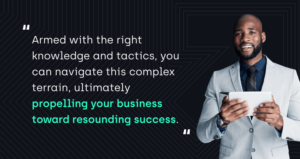In the ever-evolving world of B2B tech marketing, the art and science around demand generation strategies have grown as complex as the tech sector itself. This makes the job of filling the pipeline with marketing and sales-qualified leads a formidable task. For companies that aren’t already recognized in their field as top suppliers or a well-known lower-cost option, the hyper-crowded B2B tech market makes the job that much harder.
Marketing teams may recognize that they need help with demand gen, but they are often overwhelmed by the multitude of complex solutions and strategies available to them.
If that’s you, don’t worry; in this blog post, we will act as your tour guide through the intricate world of B2B demand generation strategies.
What Is Demand Generation and When Should You Use It?
Before we dive deeper, let’s clarify what demand generation is (and isn’t).
Demand generation is a strategy that focuses on creating awareness and interest in your products or services, with the ultimate goal of leading to sales. Done right, it helps get the right message to the right people at the right time as you build a pipeline full of potential—no matter how complex the buyer’s journey.
Many marketers, however, mistakenly confuse demand generation with lead generation. While lead generation primarily focuses on acquiring contact information that may be of use further down the funnel, demand generation takes a broader view, nurturing leads from the very first touchpoint to the final sale. Demand generation is a more comprehensive approach to the challenge of growing the sales pipeline.

When Should You Use Demand Generation?
Demand generation makes the most sense when you’re trying to achieve business goals, such as:
- Growing new business – When extending your market reach, it’s essential to create brand awareness and interest. You can’t be considered if you’re not on the list of options.
- Introducing a new product or service – The key to promoting awareness and adoption is to inform your audience. Introducing a unique positioning or clear value proposition to the right target audience can make all the difference.
- Repositioning an offering – When the market perception of your product is off—i.e., priced too high or viewed as a low-cost, low-quality substitute—you may not reach the people you are targeting, and your sales funnel will remain empty.
- Rekindling stagnant growth – Even if your market is aware of your product, they may not consider it given new entrants and industry requirements. If your sales have reached a plateau, demand generation can give your company a fresh lease on life.
- Impacting a buying committee – The old days of one-to-one buying are over. Today, we live in a one-to-many purchase environment. Sales decisions are no longer siloed in one or two areas of the company but reside across multiple stakeholders, from product development to channel marketing to operations.
Understanding the Buyer’s Journey
Let’s face it. It’s a great feeling when a supplier just ‘gets’ you. There’s no better way to set yourself apart from the competition than mastering the art of understanding every stage of the customer experience in your industry and market segment. Here’s how to do this effectively:
- Know your audience – Understanding your audience’s needs, pain points, and preferences helps you craft impactful demand generation strategies and content.
- Understand where they are on the journey – Knowing whether your customer is in the awareness, consideration, or decision phase of the buyer journey will enable you to personalize your communications effectively.
- Respect where they are – Pushing a customer down the funnel when they’re not ready is arguably the biggest mistake you can make. Instead, meet them where they are and adapt your strategies to engage and assist them based on their current stage of interest.
- Get your message right – Once you understand and empathize with a customer, you can leverage that advantage to deliver your message more strategically and maximize your impact in the competitive landscape.
How to Deliver Demand Generation at Every Stage of the Customer Journey
1. Awareness: The Critical First Step
The awareness stage of demand generation is often minimized in its value because it can be misconstrued by sales teams as “marketing fluff.” This perception, however, could not be more wrong. The awareness stage is the most important stage in the funnel in many cases.
At Yeager, we often talk about the 95-5 rule, which states that at any given time, especially in the crowded B2B tech landscape, 95% of your potential customers are not currently in-market for your products or services. So why would you focus on those who won’t be ready to buy any time soon? Shouldn’t you direct your efforts to the 5% who are looking for your services now? The truth is, if you wait to get your message out only once your customer is looking for you, you’ve already missed your opportunity. By the time people move in-market, they’ve pre-selected a set of brands they’re going to research and choose from. In order to ensure you’re in that consideration set, you need to be marketing to them long before they even enter the funnel. In doing so, you will build your brand, make it stand out from the competition, and make it instantly recognizable. Thankfully, the digital age brings us many effective and measurable options to make the awareness stage of the buyer journey a great sales lead feeder.
Some of the most common and effective tactics to help you identify prospects early in the sales cycle include:
- Display and native advertising – These ads can effectively capture attention, introduce your brand, and create initial interest among potential customers who might not have encountered your product otherwise.
- Paid social media – Paid social media campaigns on platforms like LinkedIn, Instagram, X, or Facebook provide a targeted approach to reach potential customers. By leveraging demographic and behavioral data, these campaigns can raise awareness among users who are most likely to be interested in your product or service.
- Video content – Video content is a powerful tool for storytelling and demonstrating your product’s features. If a picture speaks a thousand words, then a video speaks volumes as it engages visitors visually and emotionally. Videos make it easier for customers to understand your brand message and product benefits.
- Audio marketing – Audio channels like podcasts and music streaming services allow you to connect with potential customers through their preferred audio channels. This allows them to become aware of your brand and offerings in a rich yet less intrusive manner.
Of course, any of these tactics will only be successful when part of a cohesive strategy, paired with the right messaging to cut through the noise and get on the radar of your potential future customers.
2. Consideration: Nurturing Potential Leads
During the consideration phase, your primary aim is to educate and assist your audience in making informed decisions. To achieve this, it’s critical to avoid the sales-driven urge to over-gate your content. Instead, focus on making it easily accessible by only gating high-value assets like ebooks or research reports. Any content that is going to help your customer make a decision about purchasing from you (i.e., case studies, videos, or even white papers) should be fully ungated. Why would you want to make it harder for people to find the information that will help them choose you?
In this phase, inbound and multi-touch tactics can play a significant role in guiding your audience through their decision-making process, such as:
- Email marketing – Leverage targeted email campaigns to engage and convert potential customers.
- SEO optimization – Enhance your website’s visibility in search engine results, helping people find you when they are actively searching for your services.
- Organic social media efforts – Utilize unpaid strategies to build a community and engage with current and potential customers on social platforms.
- Paid social media campaigns – Invest in advertising to promote products or services to effectively reach and convert potential customers through paid placements on social media platforms.
- PPC (SEM) advertising – Pay-per-click search advertising on search engines helps ensure you are seen as a top option when people are in the active state of looking for products like yours.
3. Decision: Sealing the Deal
When potential customers reach the decision-making stage, your goal is to streamline the process and make it as effortless as possible for them. It doesn’t matter how good your campaign is if you’re driving users to a page or site that provides a poor experience or doesn’t match their expectations. Utilizing landing pages, microsites, and digital experiences can be instrumental in engaging users and prompting conversions, providing a clear and compelling path toward their final choice.
Here are a few highly effective tactics for ensuring your audience can confidently make informed decisions while engaging with your offerings:
- PPC campaigns – Pay-per-click advertising allows businesses to bid on keywords and display their ads prominently in search engine results or on other platforms, driving immediate traffic and potential leads.
- Paid social media initiatives – Various paid strategies, including sponsored posts, promoted content, and social media advertising, will help you effectively reach and engage specific audience segments, expand brand reach, and generate leads through social platforms.
- Targeted email marketing – Focus on sending highly personalized and relevant email campaigns to specific segments of an audience, nurturing leads, and driving conversions through tailored content and messaging.
How to Build Winning Demand Generation Strategies and Programs
Demand generation strategies must be carefully planned and executed to be successful. Here are three priorities you should focus on for successful campaigns:
- Gain understanding – Priority one should be carefully understanding your target audience and their unique problems. By doing so, you can effectively address the requirements and concerns of your potential customers by tailoring your messaging to suit them. Grab your audience’s attention and establish a solid first connection by creating messaging that speaks directly to their problems.
- Develop a strategy – Having a clear strategy in place is crucial. The entire buyer journey, from the awareness stage to the decision phase, should be mapped out in terms of content and messaging. This all-encompassing plan guarantees a cogent omnichannel strategy where every interaction and piece of content is in line with your main objective. It enables a smooth transition as prospects move through the phases of their buying experience, assisting them at each moment with pertinent information and offers.
- Make decisions – Finally, data-driven decision-making and continuous optimization are vital components of demand generation success. Measure every aspect of your campaign meticulously and use the insights gleaned from this data to inform your optimization efforts. Whether it’s adjusting messaging, refining targeting, or reallocating resources, data-driven optimization helps you fine-tune your strategies for maximum impact, ensuring that your demand generation strategies remain effective and adaptable in an ever-changing landscape.
How to Measure Success
For any demand generation program to deliver success, you must select the right key performance indicators (KPIs). It’s imperative that your chosen KPIs are in alignment with your campaign objectives, ensuring that they accurately measure progress toward your intended goals. Equally important is the demand for consistent and transparent reporting. Regular and clear reporting of KPI data is essential for making informed decisions and tracking the effectiveness of your campaigns over time. This combination of strategic alignment and rigorous reporting helps drive campaigns toward successful outcomes and allows for data-driven adjustments as needed.
Putting It All Together
In the fiercely competitive B2B tech sector, demand generation is key to capturing tangibly valuable leads. Marketers must recognize that demand cannot be captured until it’s first created through effective awareness-building strategies. A thriving demand generation program must extend its focus across the entirety of the buyer journey, guiding prospects from awareness to informed decision-making.
The intricacies of the B2B tech industry underscore the need for a strategic and holistic approach. In this dynamic landscape, collaborating with a specialized agency can help foster actionable and successful campaigns. At Yeager, we’ve developed a tried and true marketing approach that combines our best practices with a ‘what works now’ strategy and implementation roadmap to create best-in-class marketing initiatives to help companies create better, faster results. To learn more about Yeager GPS for demand generation, content, branding, and research, check out the recent blog by our CEO, Renee.
Armed with the right knowledge and tactics, you can navigate this complex terrain, ultimately propelling your business toward resounding success. When you’re ready to put demand generation strategies to work for your team, reach out to us at Yeager.


